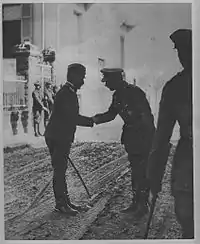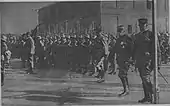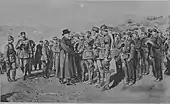Allied Army of the Orient
The Allied Army of the Orient (AAO) (French: Armées alliées en Orient) was the name of the unified command over the multi-national allied armed forces on the Salonika Front during the First World War.

When Germany, Austria-Hungary and, the newly joined ally, Bulgaria were about to overran Serbia, in September–October 1915, the returning multi-national troops from the failed Kallipoli Expedition disembarked in the Greek port of Salonika to establish the Macedonian Front. A side-effect of the landing was the further burdening the National Schism between the Greek King and the Prime minister, and the forced resignation of the latter.
By August 1916, some 400,000 allied soldiers from five different armies occupied the Salonika Front. A unified command imposed itself and after long discussions, French General Maurice Sarrail was placed in command of all Allied forces at Salonika, although they retained right of appeal to their governments.
Greece itself remained at first neutral. After a coup on 30 August 1916, the Provisional Government of National Defence, led by Eleftherios Venizelos, was created in Salonika. It started assembling an army and soon participated in operations against the Central Powers. In June 1917, after increasing pressure from the allies, King Constantine I of Greece was forced to abdicate from the throne. Venizelos assumed control of the entire country and Greece officially declared war against the Central Powers on 30 June 1917. The Greek forces also operated under command of the AAO.
Commanders of the AAO
- 11 August 1916: General Maurice Sarrail
- 15 December 1917: General Adolphe Guillaumat
- 17 June 1918: General Louis Franchet d'Espèrey[1]
Composition
France

- Armée d'Orient (1915–19): 8 divisions
Great Britain
- British Salonika Army: 6 divisions
Serbia
The Serbian armies were corps sized formations.[2]
- First Army, under command of Živojin Mišić and later Petar Bojović
- Second Army, under command of Stepa Stepanović
- Third Army, under command of Pavle Jurišić Šturm and later Colonel Miloš Vasić (dissolved in May 1917)
Russia

- 2 brigades of the Russian Expeditionary Force under command of Mikhail Diterikhs
Italy

- 35th Infantry division (Corpo di spedizione italiano in Macedonia) under
- Carlo Petitti di Roreto (July 1916 – April 1917)
- Giuseppe Pennella (26 April – 24 May 1917)
- Ernesto Mombelli (24 May 1917 – end 1918)
- XVI Italian Army Corps: This Corpo di Spedizione Italiano in Oriente (CSIO), an Italian Army Corps in Albania, remained under direct Italian HQ command and thus wasn't part of the AAO
- Emilio Bertotti (20 November 1915 – 8 March 1916)
- Settimio Piacentini (8 March – 17 June 1916)
- Oreste Bandini (18 June – 11 December 1916), was killed in the sinking of the Regina Margherita
- Giacinto Ferrero (11 December 1916)[3]
Greece

- In September 1916, 10,000 men under command of Colonels Zymvrakakis and Mazarakis
- By January 1918, 10 divisions (204,000 men) under command of Panagiotis Danglis
Others
- Portugal: 1 brigade
- Albania: 1,000 irregular troops under Essad Pasha Toptani
- Montenegro: irregular troops
Notes
- Lazarski 2008, p. 119.
- Thomas & Babac 2001, p. 12-13.
- Italian Army in Albania
References
- Lazarski, C. (2008). The Lost Opportunity: Attempts at Unification of the Anti-Bolsheviks, 1917–1919. Lanham: University Press of America. ISBN 9780761842002.CS1 maint: ref=harv (link)
- Thomas, Nigel; Babac, Dusan (2001). Armies in the Balkans 1914-18. Osprey Publishing. ISBN 1-84176-194-X.CS1 maint: ref=harv (link)